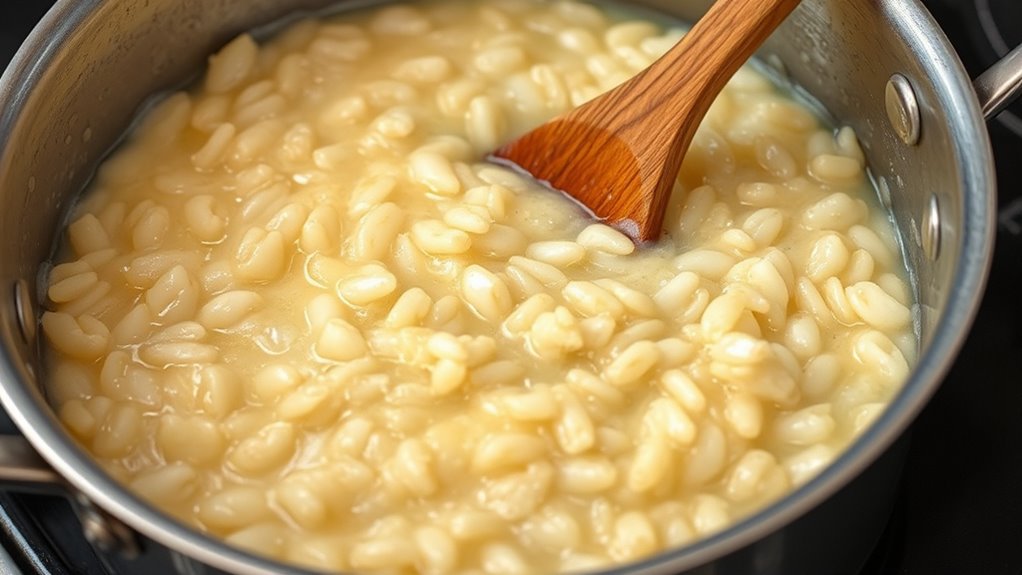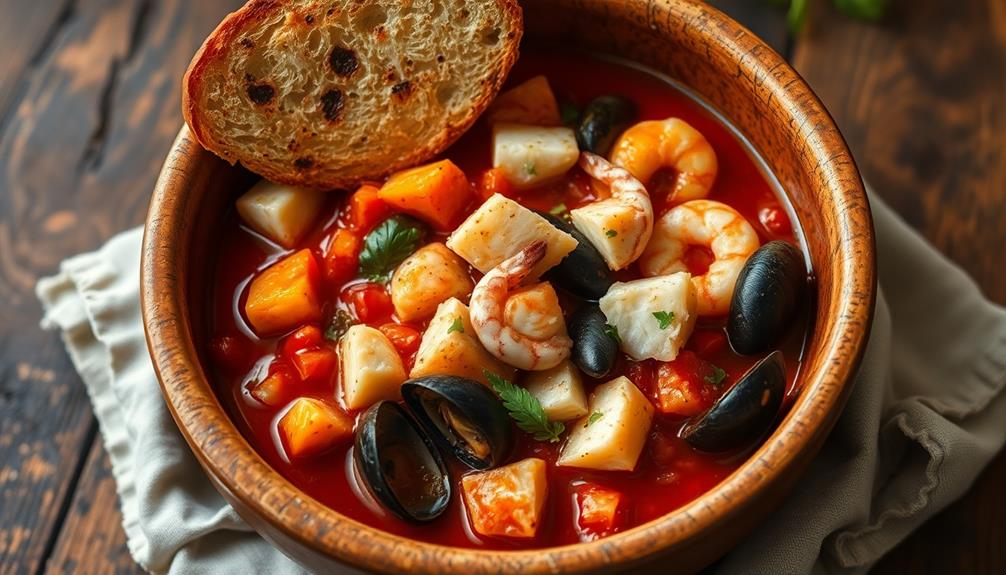To master Italian risotto, focus on proper starch gelatinization by stirring frequently to release natural starches that give the dish its creamy texture. Use high-amylopectin rice like Arborio, adding warm broth gradually and maintaining a gentle simmer to promote even starch release. Stir continuously during the initial phase, then reduce as it thickens. Perfect timing and technique are key—keep these principles in mind and you’ll craft irresistibly velvety risotto every time. Keep exploring to refine your skills further.
Key Takeaways
- Use high-amylopectin rice like Arborio or Carnaroli for optimal starch release and creaminess.
- Gradually add warm broth, stirring constantly to promote starch gelatinization and develop a velvety sauce.
- Stir frequently during initial cooking, then reduce stirring as rice absorbs liquid to prevent stickiness.
- Maintain a gentle simmer and consistent stirring to ensure even cooking and proper starch release.
- Remove from heat when rice is al dente with a creamy, velvety texture, finishing with butter and cheese.

Have you ever wondered what makes Italian risotto so irresistibly creamy and flavorful? The secret lies in mastering starch gelatinization and perfect stir timing, but understanding the role of sauce consistency and rice selection is just as important. When you start cooking risotto, your goal is to create a rich, velvety sauce that clings to each grain of rice. Achieving this requires paying close attention to sauce consistency throughout the process. As you add broth gradually, the rice releases its starches, thickening the mixture and transforming it into that signature silky texture. If you notice the sauce becoming too thin, it may be because you’ve added too much liquid at once or haven’t stirred enough to release the rice’s natural gelatin. Conversely, if it’s too thick, you might need a splash of warm broth to loosen it up, ensuring a smooth, cohesive dish. The key is to maintain a gentle simmer and keep stirring consistently to allow the starches to gelatinize properly, giving your risotto its characteristic creaminess. Additionally, understanding the contrast ratio of your cooking process helps in achieving the perfect balance between liquid and rice, ensuring optimal texture and flavor.
Choosing the right rice is crucial, as different varieties vary in their starch content and cooking properties, directly impacting the final texture. Not all rice is suitable for risotto; you want a variety with high amylopectin starch content, like Arborio, Carnaroli, or Vialone Nano. These rice types have the right grain size and starch profile to produce that luscious, creamy sauce. When selecting rice, look for grains that are plump and uniform in size, which helps them cook evenly and release the right amount of starch. The rice’s ability to absorb liquid without losing its bite is essential for achieving the perfect texture. Before cooking, rinse the rice lightly to remove surface starch that might make the final dish overly sticky, but don’t wash away all the surface starch—you still want enough to gelatinize during cooking.
Timing your stir is a skill you develop over time. You should stir frequently, especially when you first add the broth, to encourage starch release. As the rice absorbs liquid, reduce the frequency but continue to stir gently. This constant movement prevents sticking and promotes even gelatinization. Remember, patience is key; rushing this process can result in uneven cooking and a watery or overly thick sauce. When the rice reaches al dente, with a slight bite yet creamy, it’s time to remove it from heat and finish with butter and cheese for that final luxurious touch. By paying attention to sauce consistency, choosing the right rice, and stirring at the right times, you’ll master the art of perfect risotto every time.
Frequently Asked Questions
What Rice Varieties Are Best for Authentic Risotto?
You should choose rice varieties like Arborio, Carnaroli, or Vialone Nano for authentic risotto because they have the ideal rice texture and starch release. These types release just the right amount of starch during cooking, creating the creamy consistency that defines good risotto. Their ability to absorb liquids slowly while maintaining a firm core makes them perfect for achieving that rich, velvety sauce you want in a traditional risotto.
How Does Altitude Affect Risotto Cooking Times?
Like climbing a mountain changes your view, altitude affects risotto cooking times. Higher elevations mean thinner air, which causes water to boil at lower temperatures, slowing down altitude cooking. You’ll need to make risotto adjustments by increasing cooking time and possibly adding a bit more broth to achieve that creamy texture. Keep an eye on the rice, stir more often, and don’t rush—patience is your new secret ingredient.
Can I Make Risotto Vegan Without Sacrificing Creaminess?
You can make risotto vegan without sacrificing creaminess by using dairy alternatives like coconut milk, cashew cream, or oat milk, which add richness. To boost flavor, incorporate nutritional yeast, sautéed mushrooms, or roasted garlic. Stir constantly to release starches and create that characteristic creamy texture. These swaps guarantee your vegan risotto remains flavorful and velvety, providing a satisfying, dairy-free meal that rivals traditional versions.
What’s the Ideal Broth Temperature for Risotto?
Think of broth temperature as the heartbeat of perfect risotto—keeping it just right guarantees a steady rhythm. For ideal cooking consistency, you should keep your broth hot at around 165°F to 170°F (75°C to 77°C). This prevents the rice from cooling down and helps it absorb flavors evenly, creating a creamy texture. Maintaining this temperature allows your risotto to cook smoothly, achieving that luxurious, restaurant-quality finish you’re aiming for.
How Do I Prevent Rice Sticking to the Pan?
To prevent rice from sticking to the pan, start with proper pan prep by using a non-stick or well-seasoned pan. Maintain good heat control, avoiding high heat that can cause sticking and burning. Stir the rice consistently, especially during the initial stages, to release starch and keep it moving. Adding a splash of warm broth gradually helps maintain moisture and prevents sticking, ensuring your risotto stays creamy and smooth.
Conclusion
Now that you understand the science behind risotto’s creamy texture and the importance of timing your stir, you’re ready to master this dish. Think of the starch gelatinization as your secret ingredient and the stir as your rhythm—both essential, yet contrasting. With patience and attention, you’ll create a dish that’s both science and art. So, embrace the process, and let each stir bring you closer to perfect Italian risotto.









